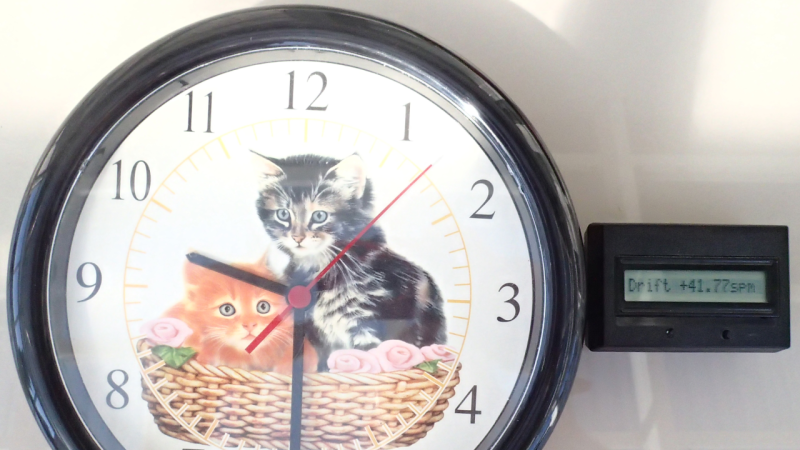Wall clocks! Are they very accurate? Well, sometimes they are, and sometimes they lose minutes a day. If you’ve got one that needs calibrating, you might like this device from [Lauri Pirttiaho].
Most cheap wall clocks use very similar mechanisms based around the Lavet-type stepper motor. These are usually driven by a chip-on-board oscillator that may or may not be particularly accurate.
[Lauri] desired a way to tune up these cheap clocks by using GPS-level timing accuracy. Thus began a project based around a CY8KIT evaluation board from Cypress. The microcontroller is paired with a small character LCD as a user interface, and hooked up to a cheap GPS module with an accurate 1-pulse-per-second (1PPS) timing output. The concept is simple enough. Clock drift is measured by using counters in the microcontroller to compare the timing of the GPS 1PPS output and the pulses driving the Lavet-type stepper motor. The difference between the two can be read off the device, and used to determine if the wall clock is fast or slow. Then one need only use a trimmer capacitor to tweak the wall clock’s pulse rate in order to make it more accurate.
Few of us spend much time calibrating low-cost wall clocks to high levels of accuracy. If that sounds like a fun hobby to you, or your name is Garrus, you would probably find [Lauri]’s device remarkably useful. Believe it or not, this isn’t the first clock calibrator we’ve seen, either. Meanwhile, if you’ve brewed up your own high-accuracy timing hardware, feel free to let us know on the tipsline.
















I’d love to see this done to a regular pendulum clock. Perhaps by influencing the pendulum.
yes, that would be nice. I thought about building taht for my grandfather clock, the pedulum should swing with 0,94sec so not easy to measure – but…. didn’t find the time for it :-D
Thats exactly how a pendulem clock is regulated. There is typically a thumb nut at the bottom of the arm that is used to raise or lower the pendulum. Raising the weight speeds the clock up and lowering the weight slows the clock.
For a tower clock it has to be adjusted based on a average temperature, and its a few turns of difference between summer and winter, mainly due to viscosity of the oil. It’s fascinating that mostly everything drifts with temperature, but we managed to reduce the error by a few orders of magnitude by making things smaller and temperature compensated.
From the wording of the title, and the picture, I was expecting a hammer (ok, a solenoid) to smack the side of the clock to “re-calibrate” it.
Stop!
Hammer time.
Wondering if you could get a cheap GPS module and use the PPS output to drive the stepper. If I’m not mistaken the motor is normally driven by a crystal derived pulse per second and I suspect that the motor drive current might be low enough to drive directly from the GPS output. Anyone ever done this so they can tell me why it won’t work?
I think you’d need a 6 degree per step stepper motor (assuming you’re driving the controller’s step pin directly from the PPS output), which don’t seem to exist (or are hard to find at least!).
You could pipe it into some form of pulse multiplier, but I don’t know of a simple IC that could do this off the top of my head.